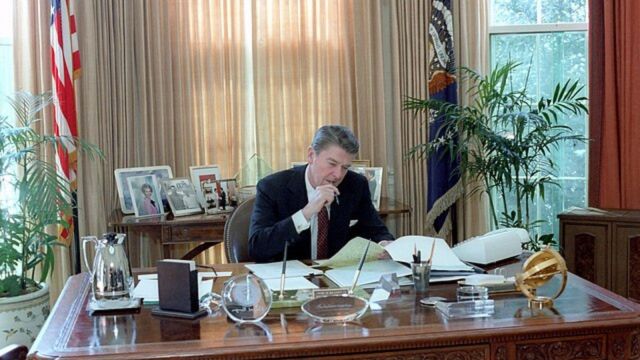Stay updated with the latest - Click here to follow us on Instagram
From Reagan to Trump: The cold-weather ceremonies that made inauguration history
The 1985 ceremony was originally planned for the Capitol’s west front, as is customary, but the extreme weather prompted a last-minute move to the Rotunda.
 The 1985 ceremony marked only the third time in US history that an inauguration was held indoors. (Wikimedia Commons photo)
The 1985 ceremony marked only the third time in US history that an inauguration was held indoors. (Wikimedia Commons photo)When Donald J. Trump stepepd into the Capitol Rotunda on Monday to be inaugurated as the 47th President of the United States, he joined a rare club of leaders who have had their swearing-in ceremonies moved indoors due to extreme weather. The decision marks the first indoor inauguration since 1985, when President Ronald Reagan, facing historically frigid temperatures, opted to take his second oath of office away from the biting winds and bitter cold that gripped Washington.
That year, temperatures plunged to a bone-chilling 7°F (-14°C), with a wind chill that made outdoor exposure potentially dangerous. For Reagan, who was nearing 74 at the time, the decision was driven by safety concerns — not just for himself but for the tens of thousands who would be part of the pageantry that surrounds every presidential inauguration. According to Larry Speakes, the White House press secretary during Reagan’s administration, the president and first lady Nancy Reagan were disappointed but understood they had little choice.
“There was high-level medical and military consultation, and it was just a very serious problem for health and safety,” Speakes told reporters in January 1985, as archived transcripts from the Ronald Reagan Presidential Library reflect. “It was just obvious… they would have had severe frostbite, if not some conditions that could have been worse.”
A rare tradition, indoors
Reagan’s 1985 ceremony, which was initially planned for the Capitol’s west front, became only the third inauguration to be held indoors, joining President James Monroe in 1817 and President William Howard Taft in 1909. For Monroe and Taft, rainy weather forced the change, but for Reagan, it was the life-threatening cold that prompted the move.
Even with his advanced age, Reagan, known for his cowboy-tough demeanor, was unconcerned for his own health, Speakes recalled, but the well-being of others involved in the event weighed heavily on him. Parade participants, military members, and the crowds that would line the National Mall faced the risk of frostbite in minutes, particularly given the powerful wind chill.
The result was a more subdued ceremony, held in the intimate confines of the Capitol Rotunda. The space, designed in the late 18th century, lent a reverence and solemnity to the event but lacked the grand scale of an outdoor inauguration that traditionally unfolds before vast crowds, the Mall stretching out as a sea of people in front of the new leader. The parade, a hallmark of every inauguration, was canceled.
A historical echo for Trump
Now, 40 years later, Trump, who turned 78 in June, will follow Reagan’s lead, moving his own ceremony indoors as a powerful cold front again bears down on the nation’s capital. Weather reports suggest below-freezing temperatures will make an outdoor event unfeasible, particularly with an octogenarian, President Joe Biden, attending the proceedings. Biden, who will be 82 at the time of the event, is scheduled to be part of the audience as his successor takes the oath.
 Now, 40 years later, Trump, who turned 78 in June, will follow Reagan’s lead. (AP photo)
Now, 40 years later, Trump, who turned 78 in June, will follow Reagan’s lead. (AP photo)
The indoor inauguration serves as an eerie historical echo, bridging two very different Republican presidents who share more than just the coincidence of extreme weather. Both Reagan and Trump have been larger-than-life figures, known for their performative charisma and deep connection to their political bases. Yet, they found themselves in these rare, intimate settings, indoors at the Capitol, swearing allegiance to the Constitution while the deep freeze settled in outside.
For Trump, who has often embraced spectacle, the move to the Rotunda may feel like a diminished platform. Yet, like Reagan, the significance of the moment will not be lost.
With inputs from AP



- 01
- 02
- 03
- 04
- 05




























